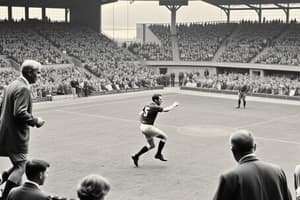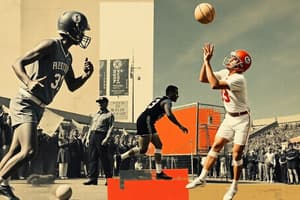Podcast
Questions and Answers
Explain how new media has changed the way athletes communicate with fans, bypassing traditional media outlets.
Explain how new media has changed the way athletes communicate with fans, bypassing traditional media outlets.
Athletes can now use social media and streaming platforms to directly engage with fans, sharing news and content without relying on traditional media's filtering or interpretation.
Describe how sports serve as an identity-constructing mechanism, providing examples beyond team affiliation.
Describe how sports serve as an identity-constructing mechanism, providing examples beyond team affiliation.
People use team affiliations to construct personal and group identities. Sport metaphors (e.g., 'slam dunk') are prevalent in American business, politics.
How do economic factors, such as fantasy sports and sports betting, contribute to fan engagement and revenue streams in the sports industry?
How do economic factors, such as fantasy sports and sports betting, contribute to fan engagement and revenue streams in the sports industry?
Fantasy sports and sports betting increase fan engagement by adding new investment in outcomes, creating more revenue through fees, advertising and expanding fan bases.
Explain how communication is used for crisis management within sports organizations. Provide an example of a recent sports crisis.
Explain how communication is used for crisis management within sports organizations. Provide an example of a recent sports crisis.
How does the concept of 'hegemonic masculinity' relate to sports, and what are its potential negative impacts?
How does the concept of 'hegemonic masculinity' relate to sports, and what are its potential negative impacts?
Differentiate between the 'social scientific approach' and the 'humanistic approach' to studying communication in sports, highlighting their methodologies.
Differentiate between the 'social scientific approach' and the 'humanistic approach' to studying communication in sports, highlighting their methodologies.
How do sports leagues and organizations utilize 'sport communication' to enhance fan engagement and media coverage?
How do sports leagues and organizations utilize 'sport communication' to enhance fan engagement and media coverage?
Explain how the COVID-19 pandemic highlighted the integral role of sports in everyday life, beyond just entertainment.
Explain how the COVID-19 pandemic highlighted the integral role of sports in everyday life, beyond just entertainment.
Describe how sports media contributes to the construction of a sense of belonging and identity through storytelling and shared experiences.
Describe how sports media contributes to the construction of a sense of belonging and identity through storytelling and shared experiences.
Compare and contrast 'BIRGing' and 'CORFing' in the context of sports fandom, and explain why fans engage in these behaviors.
Compare and contrast 'BIRGing' and 'CORFing' in the context of sports fandom, and explain why fans engage in these behaviors.
Explain how the barriers between fans, media, and organizations are blurring in the 21st century due to digital media and direct fan engagement.
Explain how the barriers between fans, media, and organizations are blurring in the 21st century due to digital media and direct fan engagement.
Differentiate between a 'Fan' and a 'Spectator' in the context of sports, highlighting the level of emotional investment involved.
Differentiate between a 'Fan' and a 'Spectator' in the context of sports, highlighting the level of emotional investment involved.
Describe how sports teams symbolize community resilience, providing examples of sports uniting cities after tragedies.
Describe how sports teams symbolize community resilience, providing examples of sports uniting cities after tragedies.
How do rituals in sports, such as the seventh-inning stretch, create a sense of community and belonging among fans?
How do rituals in sports, such as the seventh-inning stretch, create a sense of community and belonging among fans?
How has technology reshaped fan experiences in sports, making them more interactive and personalized?
How has technology reshaped fan experiences in sports, making them more interactive and personalized?
Flashcards
Communication
Communication
The exchange of verbal/nonverbal messages in specific contexts, influenced by individual and societal forces, embedded in culture.
Sport
Sport
Repeatable, regulated, physical contest producing a clear winner.
Media and Sport
Media and Sport
Traditional (TV, newspapers) and new media (social media) shaping sports perception.
Sport as Identity
Sport as Identity
Signup and view all the flashcards
Sport Communication
Sport Communication
Signup and view all the flashcards
Hegemonic Masculinity
Hegemonic Masculinity
Signup and view all the flashcards
Media, Sports, & Society
Media, Sports, & Society
Signup and view all the flashcards
Social Scientific Approach
Social Scientific Approach
Signup and view all the flashcards
Humanistic Approach
Humanistic Approach
Signup and view all the flashcards
Critical Approach
Critical Approach
Signup and view all the flashcards
Sportsugese
Sportsugese
Signup and view all the flashcards
Sportspeak
Sportspeak
Signup and view all the flashcards
Fanship
Fanship
Signup and view all the flashcards
Fandom
Fandom
Signup and view all the flashcards
BIRGing
BIRGing
Signup and view all the flashcards
Study Notes
The Role of Sport in Society
- Sports are ingrained in American culture and significantly impact the economy, society, and identity.
- The COVID-19 pandemic highlighted the essential role of sports in everyday life.
Communication's Role in Sport
- Communication shapes fan experiences, athlete identities, and media portrayals.
- It is used for messaging, identity formation, interpersonal interaction, and managing crises in sports organizations.
Media and Sport
- Traditional media (TV, newspapers) and new media (social media, streaming) are key in shaping public perception of sports.
- Athletes, leagues, and teams can now directly communicate with fans, bypassing traditional media channels.
Sport as an Identity-Constructing Mechanism
- People align with sports teams to build personal and group identities.
- Sports metaphors and language are common in American conversations and discourse.
Economic and Commercial Aspects of Sport
- The sports industry generates billions annually through ticket sales, media rights, sponsorships, and merchandise.
- Fantasy sports, sports betting, and esports have increased fan engagement and different revenue streams.
Historical and Academic Perspectives on Communication and Sport
- Early scholars understood sports reflected and strengthened cultural values.
- Sport communication research includes mass media, personal interactions, crisis communication, and performance of identity.
Key Definitions for Sport
- Communication involves people creating meaning through exchanging verbal and nonverbal messages in specific contexts, influenced by societal forces and culture (Alberts, Nakayama, & Martin, 2012).
- Sport consists of a repeatable, regulated, physical contest that produces a clear winner (Bell, 1987).
- Play involves nonutilitarian physical or intellectual activity pursued for its own sake (Guttmann, 1978).
- Games involve organized play.
- Contests consist of games that have winners and losers.
- Sports are characterized as ‘playful’ physical contests that involve nonutilitarian contests that include an important measure of physical as well as intellectual skill” (Guttmann, 1978).
- Sport communication includes the study of how communication is used in sports, including media coverage, fan engagement, and organizational messaging.
- Hegemonic masculinity defines the dominant features of masculinity for a culture, in which it often emphasizes power, strength, and control (Trujillo, 1991).
- Media, sports, and society involves a research disposition that explores the intersection of spots, media, and their impact on society (Wenner, 2015).
- Sport communication as a profession involves a research disposition that focuses on the roles for professionals in sports media and communication (Wenner, 2015).
- Communication studies and sport involves a research disposition that examines sport as a practice and how it’s studied within communications (Wenner, 2015).
- Social scientific approach involves a research tradition that values objective studies of communication behaviors to test, predict , and generalize phenomenon.
- Humanistic approach involves a research tradition using qualitative analysis for communication.
- Critical approach prioritizes how power influences communications practices for social change.
- Sportsugese was coined in 1959 by Tannenbaum and Noah to describe the influence of sports language on culture. Sportspeak was introduced in 1975 by Robert Lipsyte to describe how sports language is used in media.
Key Players in the Community of Sport
- Participants- athletes from casual to professional levels
- Sports organizations- governing bodies, leagues and other clubs that structure sports
- Sports media- Journalists, broadcasters and media content creators who shape narratives
- Fans- individuals and groups that form the cultural and economic backbone of sports
The Participant’s Role in Sport
- Casual play includes spontaneous play that serves as an introduction to port ( influenced by personality, resources, social contacts, and athletic ability)
- Intramural sports involves organized recreational leagues that benefits social, physical and academic needs
- Amateur athletics- viewed as pure form of sport to be played for passion rather than money.
- Professional athleticism- participation in sports for the highest level, and associated with financial compensation and marketability
Influence of Sports Organizations
- Athletic clubs- facilitate local sports participation
- State & National Federations- oversee competitions and advocate for athlete welfare
- Organizing committees- coordinates major events like olympics and NCAA tournaments
- Team Networks- manage branding, marketing and media presence for teams
Role of Sports Media
- Visibility Jobs includes broadcasters, analysist and sports journalists who cover events
- Production Jobs includes roles like producers, editors, and photographers
- Hybrid Jobs includes roles that are digital and social media focused
Fan Engagement and Identity
- Fanship is a defined as a connection exhibited toward a favorite team.
- Fandom is defined as a connection to other fans.
- 4 modes of fan consumption inlcude: First-person supporter (attends games in person), Home-dwelling devotee (follows through media), Social sports addict (engages with sports in social settings), Virtiual world aficionado (engages online).
Psychological & Social Aspects of Fandom
- Emotional Appeals involve fans watching for entertainment, stress relief, self-esteem, and escape.
- Cognitive Appeals involve fans learning about history, geography, politics, and culture.
- Behavioral Appeals are defined as fans engaging in sports for economic/social reasons.
Identification and Community
- Identification involves communication in which individuals have things in common.
- Media and organizations create a sense of belonging/identification through shared experiences.
- BIRGing (Basking in Reflected Glory) is when fans associate with team successes ("we won").
- CORFing (Cutting Off Reflected Failure) is when fans distance from losses ("they lost").
Changing Role of Fans
- Fans now have greater influence through social media and direct engagement with teams.
- Seattle Sounders use a fan-ownership model: season ticket holders vote on major team decisions.
Sports, Scandals, & Influence
- Sport unifies communities in times of crisis such as the Houston Astros after Hurricane Harvey/
- Scandals damage community trust, and ethical dilemmas arise when winning conflicts with fair play and integrity.
- The barriers between fans, media, and organizations are blurring.
- Greater investment in sports has amplified fan reactions.
- Social and cultural sports bonds are stronger and influence identities.
Sports Fandom
- Fan derived from "fanatic" which includes a strong sense of devotion to a sport/team.
- Spectator is someone who watches without deep emotional investment.
- Fandom the culture and passion often driven by emotional investment.
- Essential role of fans is to drive economic and cultural success of sports
Identification of Fans
- Fair weather fans only like to follow a team in cases of winning
- Die-hard fans remain loyal regardless of the team's success/failure.
- Social fans follow sports for social interactions.
- Focused fans identify with a team with civic connections.
- Vested fans are deeply emotionally attached
- Dysfunctional fans can be overly aggressive with hostile behavior.
Aesthetic Motivations
- Aesthetic beauty reflects appreciation for artistry and skill of the game.
- Achievement provides a sense of personal accomplishment .
- Drama reflects the excitement of close games.
- Escape lets people temporarily forget stress.
- Knowledge creates desire to use strategies
- Social connection lets people bond with coworkers
Basking in Reflected Glory
- Fans who associate with team success
- Cutting Off Reflected Failure creates a distance from losses
- Cutting Off Future Failure lowers expectations
- Glory Out of Rival's Failure takes pleasure in a loss
Modern Sport Symbolism
- Teams represent more than entertainment but symbols of resilience and community.
- Many sport games have united after tragedies like the saints winning after katrina.
- Some fans can turn against their own teams
Tailgataing
- A pre-game tradition reinforces loyalty.
- Face painting is visual and expresses pride for teams
- Group participations in chants foster shared experience
- Viewing sports with family strengthens bond.
- Extreme fan groups are known for intensity.
- Ethical consideration happens when behavior crosses line
Fans in the Digital Age
- Fans now create their own sports content through social media.
- Communities allows fans to spread traditions
- Social media enables interaction between fans, teams and athletes
Mythology
- Myth involves a story designed to explain the world.
- Ritual is when myths are enacted through repeated actions or ceremonies.
- Heroes consist of people who embody ideals and serve as models.
Sports Narratives
- Sports narratives use references such as "David vs. Goliath".
- Baseball has turned into a national pastime that’s embedded into culture.
- The narrative paradigm involves communication through narratives.
Spectacle in Sport
- Major events are referred to as mythic spectacles.
- Sports creates a community like baseballs seventh stretch
- Sport heroes face complex hero personas
Religion & Sport
- Sporting events mirror religion with excitement
- Inspired journeys are likened too religion
- Interpersonal Communication - exchange of messages involving those connected to sport, including athletes, coaches and spectators
- Sport Socialization- individuals learning and internalizing the norms, values and associated with sport
- Parental Pressure and Support- exerting influence on childrens sports participation
- Coaching Styles- the methods coaches use to leave, including autocratic democratic, social support and more
- Positive Coaching -positive reinforcement, character building and enjoyment
Coaching, Pressure, Sports Culture
- Sports shift to game culture
- Increase specialized pressure in youth
- Parents shape children’s experiences
- Sports emphasis on winning relationship and ethical dilemmas
- Challenges to managing parents expectations
- Leadership uses multidimensional autocratic features
- Adjusting coaching skills to performance Team and Group Team/Group Cohesion- Sense of belonging as a function of team membership.
- Group Norms- Accepting behavior within a team and how team members are socialized.
- Leadership Power- Leaders being the base of power to influence team members.
- Social identity- influence to have individuals feel connected to their social groups
- sports&culture development of sex-segregated games.
Influence and Sports
- Cohesive behavior can improve coaches performances
- Acceptable team building behavior includes skill development, while inacceptance includes abuse and degradation
- Power influence can provide leadership to team members
- Team indentificaiton positively impacts an well-being and social connections,
effective leaders reward a combination of coercive, reward, legitimate, referent, and expert power to use influence
Studying That Suits You
Use AI to generate personalized quizzes and flashcards to suit your learning preferences.



